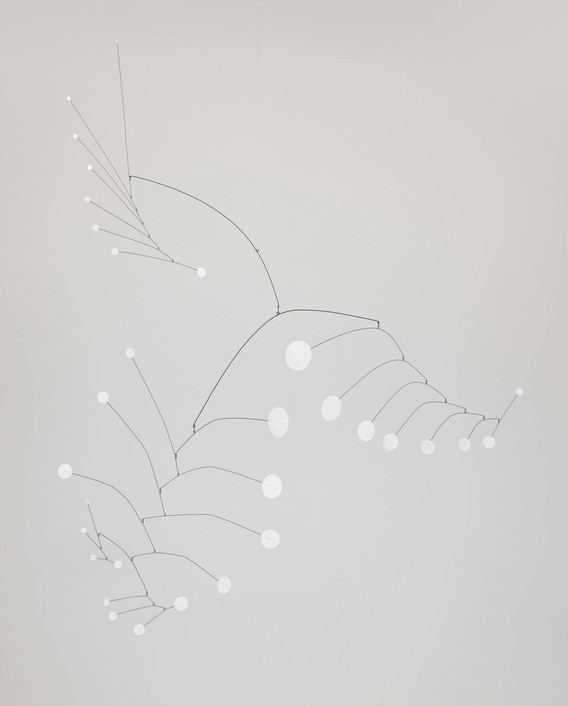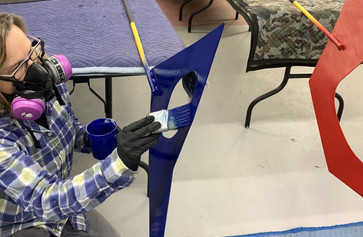
Calder Plays Theremin
Watch and listen as composer and sound artist Dorit Chrysler uses Alexander Calder’s sculptures to make music.
Cara Manes, Dorit Chrysler
Dec 16, 2021
In conjunction with the exhibition Alexander Calder: Modern from the Start, MoMA commissioned Berlin-based composer and sound artist Dorit Chrysler to make a sound piece by having Alexander Calder’s sculptures interact with the theremin, her primary instrument. Chrysler identified two of Calder’s mobiles in the exhibition to activate: Snow Flurry, I (1948, on view on the third floor) and Man-Eater with Pennants (1945, on view in the Abby Aldrich Rockefeller Sculpture Garden). Over the course of an autumn evening, Chrysler, working with MoMA conservators and art handlers, recorded the sounds and images of the sculptures’ interactions with her instruments, and from the footage she gathered composed Calder Plays Theremin, a multi-movement orchestra for the theremin “performed” by Calder’s artworks.
Calder Plays Theremin
Written for Theremin Orchestra in Four Movements, by Dorit Chrysler
First Movement: “Embrace”
The protagonists encounter each other, introduce and approach, intertwining for the first time.
Second Movement: “Fractals”
Each finds their own voice and communicates with the other; a dialogue ensues.
Third Movement: “Brute”
Man-Eater with Pennants is a powerful work that now quite forcefully interacts with the theremins, a dark and violent component emerges, a controversial musical moment, almost like a battle, a disagreement perhaps, underlined by storm and wind in the Sculpture Garden on the day of the filming, with the grand finale of a final clash, producing a visceral sound.
Fourth Movement: “Mesmerism”
The spectators in the room are now included to witness the dialogue between Calder and theremin, the dynamic of the protagonists is further developed, mesmerism, culminating in a microtonal finale of electric sparks and true exchange.
Watch the full video in stereo below. You can also watch a version in binaural audio.
Cara Manes, an associate curator in the Department of Painting and Sculpture, and organizer of Alexander Calder: Modern from the Start, spoke with Dorit Chrysler about the creation of Calder Plays Theremin.
Cara Manes: Let’s start with the basics. Can you tell us what a theremin is and how it’s played?
Dorit Chrysler: The theremin is a simple but beautiful instrument. The Russian scientist Lev (Leon) Theremin used the invention of tubes and oscillator technology for X-ray spectroscopy experiments. By sheer accident during his research, his body interacted with these circuits and produced sound. He was also a practicing cellist, and he applied the technology to make a musical instrument, the theremin or “termenvox,” as it was originally called, in 1920—one of the first electronic instruments in existence. The human body or any other physical mass turns into a capacitor that interacts with the instrument, changing pitch and volume through the smallest movement. Motion is translated into sound without touching anything.
How did you first encounter the theremin, and learn to play it?
I am a working composer, sound artist, and performer; the main instrument in my practice for many years now has been the theremin. I moved to New York after finishing my studies in musicology and traditional instruments in Vienna. Here, I encountered the theremin at a friend’s house. I was surprised that I’d never heard of this instrument before. Intrigued by its unusual interface—that it could be played without touch—I also found the theremin unusual in its intricate dynamic range, relating more to an acoustic than electronic instrument.
At that time, the theremin was even more obscure, so I had to teach myself—which I embraced, as it gave me a lot of autonomy to experiment in new styles of expression. The challenge of playing melodies on a theremin is profound. Later, I developed playing and teaching techniques for the instrument, and wanted to make this unique instrument more widely known, which led to the founding of the NY Theremin Society, together with Suzanne Fiol (the former director of ISSUE Project Room). The NY Theremin Society is a nonprofit organization that promotes the application of theremin in the arts and education.
How did the idea to “invite” Calder to play the theremin first come about?
In the end, Alexander Calder himself really spawned the idea. When I was first invited by the Calder Foundation to visit their New York offices, I found myself surrounded by many of the artist’s large-scale works. Calder’s mobiles have strong character and personality and I envisioned them instantly as active performers. The technology of theremins allows for sound production through moving objects, so it made sense to me having a moving mobile play a theremin. The potential of the intricate movements of some of Calder’s sculptures translated into microtonal sounds seemed very exciting. Placing a theremin instrument within its calibrated range close enough to moving elements of Calder’s sculpture should make this possible. What would happen? What would it sound like? It felt like this exploration of a musical dialogue between two modernist masters of sculpture and music, through their creations, demanded to be heard.
Can you take us through the structure of the composition? What was the editing process like? Were you imagining from the start that the work would be broken up into separate movements?
The idea behind the project was to conduct sound experiments on site at MoMA; to place the theremin prototypes in audible range of two selected Calder sculptures and set those sculptures in motion. We used Man-Eater with Pennants, a massive metal sculpture in the Sculpture Garden, in contrast to Snow Flurry, I, a very delicate mobile by Calder, with the idea to contrast the audio results and also because their personalities spoke to me.
Beforehand, I had no idea of what it might sound like and if it would even work and produce any usable sounds. When I went into the studio with the audio materials, I planned to construct a composition out of the recorded elements. Listening to the recordings, I was in awe of all the different colors and sonics captured. The composition literally wrote itself, and it became clear very quickly that the recordings were so varied that it made sense to create different movements. The interactions between sculpture and instruments took on an almost human aspect in their encounter.
I could have never done this without the support of an incredible team that understood the idea and added their expertise to it: Michael Tyburski, filming director, Rachael Guma, producer and sonic programmer, Joe McGinty, who brought his Model15 and programmed its patches, and Daniel Neumann, who recorded the experiments onsite masterfully. A big thank you also to the Calder Foundation and MoMA for opening its doors, and to you, Cara, for your support and faith in this project, as well as Lynda Zycherman and David Choi, who so patiently moved the sculptures for us during the recordings on site.

Alexander Calder. Man-Eater with Pennants. 1945

Alexander Calder. Snow Flurry, I. 1948
What was the experience of the Calders playing the theremins like for you? Did you encounter any surprises or unexpected outcomes during the recording sessions?
Setting up the theremins within audible range of the sculptures at MoMA was a technical and logistical challenge, and I am very grateful for everyone involved. When we finally set the mobiles in motion and heard the sounds being produced—my far-fetched idea finally taking shape at that moment—it was hard not to get emotional.
I was surprised by the sophisticated structural movement of the sculptures; they hardly ever repeated a movement within elongated circles of time, producing endless variations. The theremin instruments went through various effects that we manipulated live at times, and recorded many tracks. Later, during the editing process, I came across recordings that really surprised and almost shocked me in their rich and unique color, some of them sounding orchestral or like a black satanic mass grumble or pristine, pearly trickles that really carved the personality of the mobiles. Calder Plays Theremin produced sounds that I had never heard before, and it surpassed all my expectations. The sonic dialogue between the creations of two modernists taught me to listen closely for possible patterns of future sounds, when machines create their own compositions.
MoMA has a history of staging experimental sound performances in the Abby Aldrich Rockefeller Sculpture Garden. Were you thinking about these past events when you were in the garden?
If I could transport myself back in time, I would choose the very first analog Moog synthesizer concert, which took place in MoMA’s Sculpture Garden in 1969. For my project, I wanted to pay tribute to this rich history of electronic music at this very site. So, in addition to the theremin instruments, we brought a Moog Model 15 analog synthesizer with us. We used its unique patches, masterfully programmed by Joe McGinty, to run through a theremin that was then triggered by a Calder sculpture. The location was crucial to this project—and especially precious as Leon Theremin himself had his working studio on West 54th Street, just opposite the garden, during the early 1930s. I would like to think that both Theremin and Calder might have enjoyed their machines interacting with each other in this way. Leon could have watched it from afar, leaning right out of the window from his studio.
Alexander Calder: Modern from the Start, organized by Cara Manes, Associate Curator, with Zuna Maza and Makayla Bailey, Curatorial Fellows, Department of Painting and Sculpture, is on view through January 15, 2022.
Related articles
-

In Detail
The Many Layers of Alexander Calder’s Man-Eater with Pennants
Conservators discuss the transformation of the artist’s imposing sculpture.
Cara Manes, Megan Randall, Lynda Zycherman
Apr 2, 2021
-

Sounds from Outer Space: The Moog at MoMA
We revisit Robert Moog’s landmark “Synthesizer Concert-Demonstration” 50 years later.
Lauren Rosati, Brian Blomerth
Aug 28, 2019

